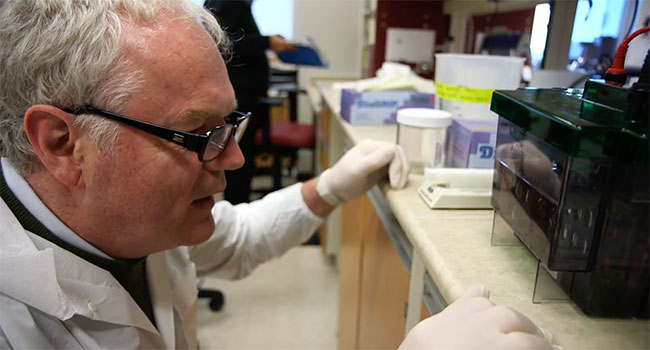Earlier this year, Michael Houghton, University of Alberta virologist and co-recipient of the 2020 Nobel Prize in Physiology or Medicine, mobilized his hepatitis C lab to join the charge to produce a vaccine for COVID-19.
His lab was a perfect fit for the endeavour, having created a successful vaccine for the SARS virus in 2004 that was never needed because that outbreak was contained.
But perhaps unlike his primary research – which, from hepatitis C virus discovery to vaccine production, will have taken better than 40 years – Houghton said what has struck him about the accelerated and colossal hunt for COVID-19 tests, therapies and even a vaccine has been how the scientific community and government have banded together.
“I think COVID – as terrible as it is and as tragic as it is – it’s actually created a new paradigm for developing vaccines,” said Houghton, Canada Excellence Research Chair Laureate in Virology, director of the Li Ka Shing Applied Virology Institute and professor in the U of A’s Department of Medical Microbiology and Immunology. “It’s showing us how fast we can develop them when the will is there.”
Houghton credited governments around the world, including the Canadian and Alberta governments, for sponsoring companies to produce vaccines at large scale, even before they know whether it works.
“Normally industry doesn’t do that.”
He’s not sure whether they will do that with hepatitis C, but the methods being used for COVID-19 research will give his lab of today advantages labs didn’t have when he was starting out.
Fellow Nobel laureate Harvey Alter began describing a blood-borne hepatitis simply termed “non A non B hepatitis” in the 1970s, but it was more than a decade before Houghton and his colleagues Qui-Lim Choo and George Kuo, who toiled for seven years using what were then the latest molecular techniques, found the virus.
“It was like looking for a needle in a haystack,” said Houghton.
But once they found it, blood tests were just a few years out. By 1992, hepatitis C had been all but eliminated from the donor blood supply, which has saved countless lives and billions in health-care costs. After that, the therapeutics took another 20 years, but hepatitis C treatments are now at the point that the viral infection can now easily be cured in virtually all patients.
In 2013, Houghton’s team at the U of A showed that a vaccine derived from a single strain of hepatitis C was effective against all strains of the virus.
Today, Houghton’s team of about 20 young scientists, most of whom have been trained in Canada, many of them in the U of A’s Faculty of Medicine & Dentistry, work to manufacture and purify a vaccine shown to be effective in animal models, with human trials scheduled for late next year.
The work on COVID-19 now has Houghton thinking about accelerated development of a hepatitis C vaccine for the community that would include vaccinating people and then, with their permission, giving them the virus. Where the vaccine fails, he said, antivirals are brought in. This approach has previously been used to come up with vaccines for malaria and dengue fever.
“You cannot stop an epidemic as large as hep C, or COVID-19, with only a good therapy. You absolutely have to have a vaccine to really curb the transmission around the world,” he said.
And while antivirals are highly effective in treating hepatitis C, the problem with them is one of economics. Houghton said treating the 12,000 Canadians per year who contract hepatitis C, fuelled by the opioid epidemic, will cost Canadians more than $1 billion.
“If our vaccine works, we think we can make enough hep C vaccine at the U of A, in Greg Korbutt’s Alberta Cell Therapy Manufacturing facility, to provide the vaccine required for all the high-risk people in Canada for around $50 million at most.
“That’s a huge cost savings at a time when we’re going to need cost savings given COVID-19 and its effect on the economy.”
Worldwide the effect will be a medical marvel. Even today, about 400,000 people die of hepatitis C around the world annually, and millions more are living with the disease, which leads to liver cancer and liver cirrhosis.
“Contrast that with a million people that have died from COVID so far this year, and you can see it is very serious,” he said.
| By Michael Brown
This article was submitted by the University of Alberta’s online publication Folio, a Troy Media content provider partner.
The views, opinions and positions expressed by columnists and contributors are the author’s alone. They do not inherently or expressly reflect the views, opinions and/or positions of our publication.


